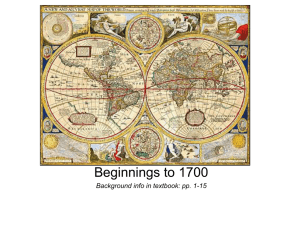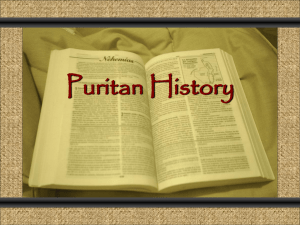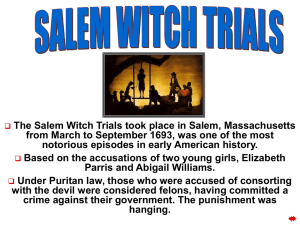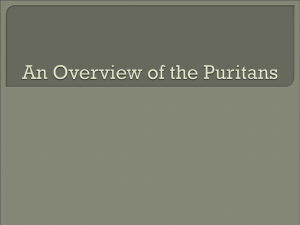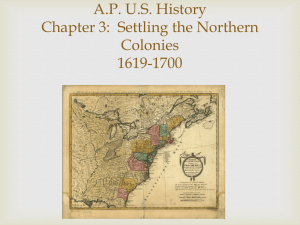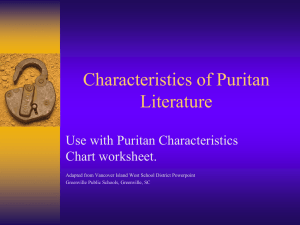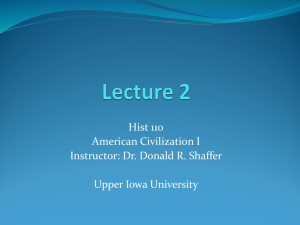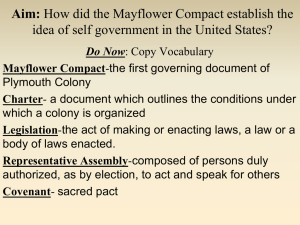2.3 The New England Colonies
advertisement
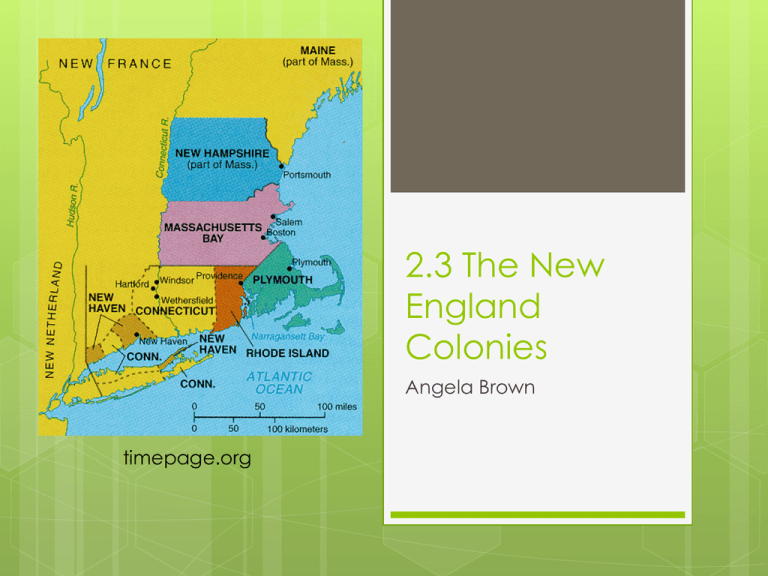
2.3 The New England Colonies Angela Brown timepage.org Learning Targets: I Can… Summarize French exploration and colonization in North America. Describe the Plymouth and Massachusetts Bay colonies in New England. Explain why war broke out between the Indians and the Puritans. Bellringer: Review Key Terms…which do you need to review? Suppose an unfamiliar group suddenly took over your classroom. How would you react? Key Terms: New England Colonies, Puritan, persecute, Pilgrim, Mayflower Compact, Great Migration, religious tolerance, Salem witch trials, sachem, Pequot War, King Philip’s War The French in North America The French had been exploring the region for decades looking for trading opportunities. Giovanni da Verrazano He was an Italian sailing for the French in 1523 – 1524 searching for the Northwest Passage. He explored the coast of North Carolina to Newfoundland and entered New York Harbor. Jacques Cartier He made 3 voyages to Canada in 1534, 1535, and 1541-42. The French king claimed a region called New France based on his exploration. New France included land in both present day Canada and the Northern U.S. He explored the St. Lawrence River as far as Montreal but did not succeed in establishing a permanent settlement in NA. Samuel de Champlain He founded the first successful French colony in NA in 1608. Quebec sits on the high ground above a narrow stretch of the St. Lawrence River. He also mapped the Atlantic shores as far as Massachusetts and traveled the inland lakes Huron and Champlain. Saint Lawrence River kids.britannica.com They traveled together from the Great Lakes to the Mississippi River in 1673. They canoed south as far as Arkansas looking for the Pacific Ocean. They learned from NA that the river flowed instead into the Gulf of Mexico. Realizing they had not found the NW passage they returned to New France. Louis Joliet and Jacques Marquette Mississippi River answers.com The Fur Trade The French discovered that fur could be sold for great gain in Europe. Clothing made from skins of deer, beaver, and other animals became highly fashionable in Europe in the 1600s. NA trapped and traded furs to the French. New France was a long, narrow colony stretching along the St. Lawrence and Great Lakes because water was vital for transporting goods. The Great Lakes umesc.usgs.gov The Iroquois NA fought over hunting territories to further their fur trade in order to trade for guns, cloth, and jewelry. Several Indian nations joined together during the late 1500s to form the Iroquois League. The Iroquois lived in New York State between the Hudson River and Lake Erie. They fought a series of wars in the mid and late 1600s pushing their rival NA west of the Great Lakes. Plymouth Colony The English were beginning new colonies in the NW region of the US known as New England. The states of Connecticut, Rhode Island, Massachusetts, Vermont, New Hampshire, and Maine would develop from this region and would be called the New England Colonies. Map of Plymouth Colony showing town locations en.wikipedia.org Puritans and Separatists In 1534 England’s King Henry VIII had broken with the Catholic Church and had founded the Anglican Church, England’s national Protestant church. Some complained that the Anglican Church continued too many of the Catholic practices and they wanted a “purer” kind of church so were called Puritans. Some Puritans started separate churches and were called Separatists. Both groups were persecuted, or attacked because of their beliefs. This lead to the first successful colony in NE. The Voyage of the Mayflower In 1620 the Pilgrims, separatist decided to come to NA to worship freely. 100 pilgrims and some non-separatists sailed to NE on the Mayflower. Afraid the group would break up, the Pilgrims made a compact, or agreement, called the Mayflower Compact. They agreed to obey all of their government’s laws. The Mayflower Compact The compact kept the Pilgrims together and showed they expected to govern themselves. Self-government would become one of the founding principles of the U.S. William Bradford, who helped draft the compact, was elected governor of the colony 30 times from 1621 and 1656. He later wrote the History of Plymouth Plantation. Mayflower: Compact, 1620 Fine Art ... fineartamerica.com Early Difficulties They started that colony at a harbor they called New Plymouth after the English port from which they sailed. Half of them died the first winter. The next summer the colonists had the help of a NA, Squanto, who taught them how to plant corn. They held a great feast of Thanksgiving in the fall of 1621. cantuar.blogspot.com Analyze: ratical.org Discuss reasons why people form political and social groups. Compare the formation of the Mayflower Compact to the formation of the Iroquois League. What were the reasons behind each group’s philosophy? How were they similar? Different? The Massachusetts Bay Colony In msfrederick7th.wikispaces.com 1630 a thousand settlers crossed the Atlantic to found the MBC a few miles north of Plymouth. This began a flood of colonists to NE called the Great Migration. By 1643 the MBC had 20,000 people living in 20 towns, The Puritans Many of the new settlers were Puritans hoping to worship as they wanted. They did not believe in religious tolerance – the idea that people of different religions should live together in peace. They had no desire to live among people who held beliefs different from their own. By law, everyone in MBC had to attend the Puritan church and pay taxes to support it. They believed that they were creating a new, pure society to serve the will of God. John Winthrop, a founder and governor, delivered this City on a Hill sermon on board the Arbella in 1630. Stating America would be an example to people throughout the world. A well-ordered Community Due to their shared goals the Puritans were united and strong. When they established a new town, they left a large are of open land as a “common” to be used by all. Facing the common was a church or meeting house, the house for the minister and a school were nearby. The rest of the land near the common was divided into house lots. Outside the town, each family had a strip of farmland. Success It was a successful plan. The Puritans worked hard, took care of themselves and each other, and enjoyed relatively good health. Children could be expected to live at least twice as long as children born in early Virginia. By 1700, NE was home to over 93,000 people living fairly comfortable lives. revival-library.org The Salem Witch Trials In 1692, several girls in Salem, Massachusetts, claimed the devil had taken control of them. They accused three people of being witches. In the public uproar that followed, neighbors accused one another of dealing with the devil. law.umkc.edu The Salem Witch Trials Trials were held. Authorities ordered 20 men and women to die by hanging. Historians believe the witch trials reflected fears about political changes taking place at the time. The Glorious Revolution had recently occurred in England William and Mary, the new monarchs joined MBC and Plymouth into one royal colony called Massachusetts. Culture: How do the Salem Witch trials reflect the Puritans’ passion for social order? The Accused Accusations of witchcraft in Salem were used to punish people who deviated from social norms. Historian John Demos, found that accused women were most likely to be middle-aged(40 – 60), married but without children, of low social status, and involved in medical care such as midwifery. ruby-slipper.hubpages.com Other Puritan Colonies With population increases, farmland grew scarce. Some Puritans were given permission to search for better farmland and create new communities in NE. endtimepilgrim.org Other Colonies Connecticut Puritan minister, Thomas Hooker, led a group of settlers in the mid 1630s. In 1639 representatives from several Connecticut towns wrote a new plan of government for their colony called the fundamental orders New Hampshire and Maine Both settlements were populated by Puritans from England and Mass. NH became a separate colony in 1680. Maine was part of Mass. Until it became a separate state in 1820. Other Separatist Colonies Some left because of religious conflicts with the Puritan leaders not farmland. Rhode Island In 1636 Roger Williams, a Separatist minister, was banished from Mass. After quarreling with Puritan authorities and started a settlement called Providence in Rhode Island. In 1644 Providence joined with other Separatist communities in Rhode Island and received permission to be self-governing. It guaranteed religious tolerance to all settlers. Other Separatist Colonies New Haven In 1638, a new group of Separatists from England founded New Haven. In 1662, New Haven and Connecticut were combined into a single royal colony. Exeter In 1638, John Wheelwright founded the settlement of Exeter after disagreement with Puritans. It soon became part of the NH Colony. Wheelwright was the brother-in-law of Anne Hutchinson. Anne Hutchinson Born in England in 1591, Anne Marbury married A wealthy merchant named William Hutchinson in 1612. In 1634 she moved with her husband and 12 surviving children to Boston to escape religious persecution and join other Puritans. Hutchinson did not accept Puritan authority. She believed it was wrong to obey the church if the person felt by doing so he or she was disobeying God. Critics of John Winthrop and the Mass. Government gathered in her home, along with women interested in studying the Bible, and others who wanted to think for themselves. Hutchinson Banished She was called to trial to explain her actions in November 1637. She defended herself with references to law and the Bible. She proved a match for her accuser and judge, Governor Winthrop. The judges rejected her claim that her own beliefs about God could override the authority of Puritan laws and leaders and declared her “unfit for our society”. She was banished from the colony. Hutchinson Banished The Hutchinsons left for Rhode Island early the next year. In 1642, after the death of her husband, She moved with her family to Long Island, New York. In 1643, Indians engaged in a war against Europeans murdered Hutchinson and her family. War with the Indians English settlers were pushing NA out of their homelands resulting in numerous wars. The Pequot War The Pequot people of Connecticut were among the first to strike against the English settlers. In 1637 the MBC responded to several incidences of violence by sending an army to attack them. This became known as the Pequot War. Pequot War The Puritans burned a Pequot fort near Mystic, Connecticut, killing over 500. They then hunted down and killed or captured the rest of the Pequot. A hand full of Pequot survived. posters.co.uk King Philip’s War In the 1660s, Metacom, was a strong leader of the Algonquin people of NE. His English name was King Phillip. He had spent much of his life moving between NA and white society. He was the son of Massasoit, the leader of the Pokanokets, who helped the Pilgrims survive the first years at Plymouth. Trade could not erase the basic tension between the Indians and English. King Philip’s War By 1670 some 45,000 English people were living in about ninety towns in NE. They were cutting down forests, putting up fences, and creating pastures which threatened the livelihood of NAs. In 1675 Metacom united Indian groups from Rhode Island to Maine in a determined effort to drive out the English. King Philip’s War it was called. He and his warriors destroyed 112 English towns, attacked 52 others and killed 600 settlers. They ruined fields, slaughtered cattle, and kidnapped dozens of people. The English Struck Back They killed or wounded about 4,000 NAs. In August of 1676 soldiers caught Metacom sleeping in his hideout near Mount Hope, Rhode Island. He was shot through the heart while trying to escape. The war continued for more than a year and devastated the economy in northern NE. When it ended, the English conquest of the region was nearly complete. Exit Slip: 1. 2. 3. What challenges did the Puritan colonists face and why do you think they succeeded in establishing permanent settlements in New England? Create a graphic organizer that compares the main characteristics of New France, Plymouth, and Massachusetts Bay Colonies. What was the Mayflower Compact and why was it important?


